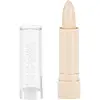What's inside
What's inside
 Key Ingredients
Key Ingredients

 Benefits
Benefits

 Concerns
Concerns

 Ingredients Side-by-side
Ingredients Side-by-side

Dimethicone
EmollientPolyethylene
AbrasiveNeopentyl Glycol Diheptanoate
EmollientEthylhexyl Methoxycinnamate
UV AbsorberTrimethylsiloxysilicate
EmollientPhenyl Trimethicone
Skin ConditioningPolyisobutene
Caprylyl Methicone
Skin ConditioningZinc Oxide
Cosmetic ColorantStearyl Heptanoate
EmollientBoron Nitride
AbsorbentOzokerite
Emulsion StabilisingSorbitan Trioleate
EmulsifyingKaolin
AbrasiveStearyl Caprylate
EmollientIsodecyl Neopentanoate
EmollientNylon-12
Triethoxycaprylylsilane
Cetyl PEG/PPG-10/1 Dimethicone
EmulsifyingOctadecenedioic Acid
EmulsifyingHexyl Laurate
EmollientPolyglyceryl-4 Isostearate
EmulsifyingDisteardimonium Hectorite
StabilisingIsopropyl Titanium Triisostearate
EmollientDimethicone/Bis-Isobutyl PPG-20 Crosspolymer
EmollientTriethyl Citrate
MaskingSilica
AbrasiveTocopheryl Acetate
AntioxidantEthylhexyl Palmitate
EmollientSorbic Acid
PreservativeCI 77891
Cosmetic ColorantIron Oxides
Mica
Cosmetic ColorantDimethicone, Polyethylene, Neopentyl Glycol Diheptanoate, Ethylhexyl Methoxycinnamate, Trimethylsiloxysilicate, Phenyl Trimethicone, Polyisobutene, Caprylyl Methicone, Zinc Oxide, Stearyl Heptanoate, Boron Nitride, Ozokerite, Sorbitan Trioleate, Kaolin, Stearyl Caprylate, Isodecyl Neopentanoate, Nylon-12, Triethoxycaprylylsilane, Cetyl PEG/PPG-10/1 Dimethicone, Octadecenedioic Acid, Hexyl Laurate, Polyglyceryl-4 Isostearate, Disteardimonium Hectorite, Isopropyl Titanium Triisostearate, Dimethicone/Bis-Isobutyl PPG-20 Crosspolymer, Triethyl Citrate, Silica, Tocopheryl Acetate, Ethylhexyl Palmitate, Sorbic Acid, CI 77891, Iron Oxides, Mica
Ingredients Explained
These ingredients are found in both products.
Ingredients higher up in an ingredient list are typically present in a larger amount.
Ci 77891 is a white pigment from Titanium dioxide. It is naturally found in minerals such as rutile and ilmenite.
It's main function is to add a white color to cosmetics. It can also be mixed with other colors to create different shades.
Ci 77891 is commonly found in sunscreens due to its ability to block UV rays.
Learn more about CI 77891Ethylhexyl Palmitate, also known as octyl palmitate, is created from 2-ethylhexyl alcohol and palmitic acid. It is a fatty acid ester.
The fatty acid content of Ethylhexyl Palmitate makes it an emollient. Emollients help soften and hydrate your skin by trapping moisture within.
Ethylhexyl Palmitate is also used to help improve the texture of cosmetics. It helps other ingredient dissolve in products and help disperse ingredients more evenly.
You'll likely find this ingredient in sunscreen, as it is often used to mix UV-blocking ingredients such as avobenzone and ethylhexyl triazone.
It can also help stabilize the fragrances in a product as a fragrance fixative.
Ethylhexyl Palmitate can be used to substitute mineral oil.
Due to its high fatty acid content, it may not be fungal-acne safe.
Learn more about Ethylhexyl PalmitateKaolin is a clay. It is used for oil control and to help minimize pores. Like other clays, kaolin has the ability to absorb excess sebum or oil. This can help clean out pores and mattify the skin.
Some types of kaolin may have exfoliating properties. When water is added to kaolin, it becomes a paste with small abrasive particles.
Most kaolin is a white color, but may be pink/orange/red depending on where it comes from.
The name 'kaolin' comes from a Chinese village named 'Gaoling'. Kaolin clay comes from rocks rich in kaolinite. Kaolinite, the mineral, has a silicate layered structure. Kaolinite is formed from chemical weathering of aluminum siilicate minerals.
Besides skincare, kaolin is commonly used to make glossy paper, in ceramics, toothpaste, and as medicine to soothe stomach issues.
Learn more about KaolinOzokerite is a naturally occuring mineral wax. In cosmetics, ozokerite is used as a texture enhancer.
Ceresin wax is derived from this ingredient.
The melting point of ozokerite is 58-100 C.
Ozokerite is found all over the world including Scotland, the US, and India.
Learn more about OzokeriteSilica, also known as silicon dioxide, is a naturally occurring mineral. It is used as a fine, spherical, and porous powder in cosmetics.
Though it has exfoliant properties, the function of silica varies depending on the product.
The unique structure of silica enhances the spreadability and adds smoothness, making it a great texture enhancer.
It is also used as an active carrier, emulsifier, and mattifier due to its ability to absorb excess oil.
In some products, tiny microneedles called spicules are made from silica or hydrolyzed sponge. When you rub them in, they lightly polish away dead skin layers and enhance the penetration of active ingredients.
Learn more about Silica